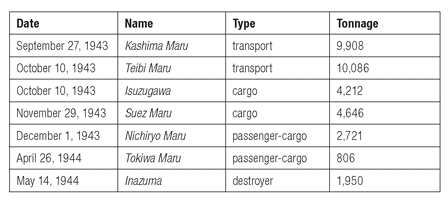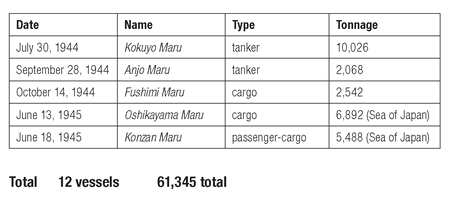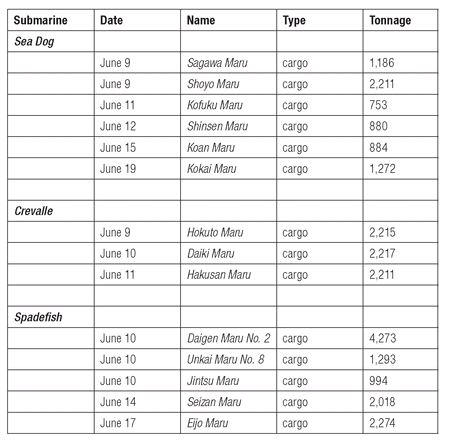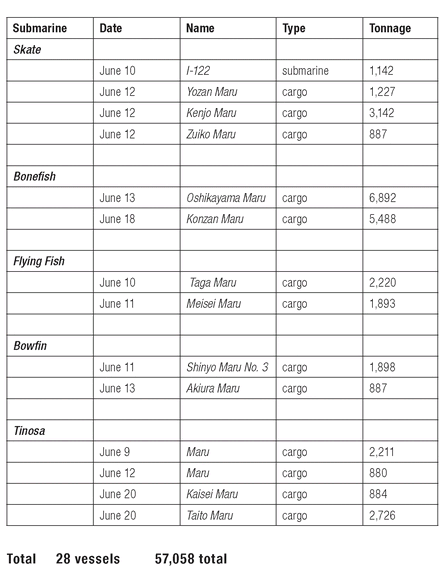Hellcats (40 page)
Authors: Peter Sasgen

Nonetheless, it's important to remember that, regardless of the various reasons for Operation Barney's existence, nothing can diminish in any way the stature and integrity of Admiral LockwoodâUncle Charlieâand his devotion to his service and his men. And nothing can diminish what the heroic Hellcats achieved during one of the most dangerous and daring operations of World War II.
Â
Â
Charles Lockwood addressed many of
the issues surrounding Operation Barney in a book he wrote in 1951 entitled
Sink 'Em All
. A memoir of the submarine war, the book provides a broad overview of that war from Lockwood's perspective as ComSubPac. He describes Operation Barney, though not in detail, and pays a special tribute to Lawrence Edge. Four years later, Lockwood wrote the full story of Operation Barney, from its inception to its execution, in a book entitled
Hellcats of the Sea
. As he did in
Sink 'Em All
, he paid tribute to Edge, this time devoting a full chapter to the
Bonefish
. There are no revelations in
Hellcats of the Sea
, but Lockwood does admit to his desire to extact revenge on the Japanese for the loss of Morton and the
Wahoo
. He inscribed a copy of his book to Sarah Edge as follows: “To Sarah as a small tribute to the memory of a gallant submariner, Lawrence Lott EdgeâGod rest his soul.”
the issues surrounding Operation Barney in a book he wrote in 1951 entitled
Sink 'Em All
. A memoir of the submarine war, the book provides a broad overview of that war from Lockwood's perspective as ComSubPac. He describes Operation Barney, though not in detail, and pays a special tribute to Lawrence Edge. Four years later, Lockwood wrote the full story of Operation Barney, from its inception to its execution, in a book entitled
Hellcats of the Sea
. As he did in
Sink 'Em All
, he paid tribute to Edge, this time devoting a full chapter to the
Bonefish
. There are no revelations in
Hellcats of the Sea
, but Lockwood does admit to his desire to extact revenge on the Japanese for the loss of Morton and the
Wahoo
. He inscribed a copy of his book to Sarah Edge as follows: “To Sarah as a small tribute to the memory of a gallant submariner, Lawrence Lott EdgeâGod rest his soul.”
Lockwood retired from the Navy in 1947. He moved to Los Gatos, California, living in a home he named “Twin Dolphins.” In retirement he devoted himself to local civic issues, writing about submarines, lecturing, and hunting. He witnessed the revolution in submarine design and technology he had anticipated with the launching in 1954 of the first nuclear-powered submarine, the USS
Nautilus
(SSN-571), and, in 1960, the deployment of the first ballistic missile-firing sub, the USS
George Washington
(SSBN-598). For Lockwood, those magnificent ships were the fulfillment of what he'd envisioned back in the dark ages of submarining: true submarines endowed with unlimited submerged endurance, high underwater speed, and deep-diving capabilities, and armed with powerful torpedoes and missiles.
Nautilus
(SSN-571), and, in 1960, the deployment of the first ballistic missile-firing sub, the USS
George Washington
(SSBN-598). For Lockwood, those magnificent ships were the fulfillment of what he'd envisioned back in the dark ages of submarining: true submarines endowed with unlimited submerged endurance, high underwater speed, and deep-diving capabilities, and armed with powerful torpedoes and missiles.
Lockwood died in 1967 and is buried in Golden Gate National Cemetery, San Bruno, California. Had Uncle Charlie lived to see photographs of the sunken
Wahoo
and the other recently discovered subs, he might not have believed his eyes. Then again, as an old submarine sailor, he knew that anything was possible, even that with time, the sea would give up its secrets. (Photos of the wrecks of the discovered submarines can be viewed on Google Images.)
Wahoo
and the other recently discovered subs, he might not have believed his eyes. Then again, as an old submarine sailor, he knew that anything was possible, even that with time, the sea would give up its secrets. (Photos of the wrecks of the discovered submarines can be viewed on Google Images.)
Lockwood's right-hand man, the brilliant Richard G. Voge, after serving as operations officer of ComSubPac, joined the staff of CNO Nimitz. Voge took on another of Lockwood's pet projects, an official administrative and operational history of the submarine force. After completing this massive work, Voge retired from the Navy in 1946 with the rank of rear admiral. He died in 1948. The histories Voge compiled were never published as originally planned but instead became the massive volume entitled
United States Submarine Operations in World War II
, published in 1949 by the United States Naval Institute.
United States Submarine Operations in World War II
, published in 1949 by the United States Naval Institute.
Chester W. Nimitz, the Navy's last fleet admiral, retired in 1947. He died in 1966 and, like Lockwood, is buried in Golden Gate National Cemetery, San Bruno, California. The Navy's current fleet of
Nimitz
-class nuclear-powered aircraft carriers are named in his honor.
Nimitz
-class nuclear-powered aircraft carriers are named in his honor.
Fleet Admiral Ernest J. King retired in 1945 after relinquishing his post as CNO to Admiral Nimitz. King died in Kittery, Maine, in 1956.
Captain Earl T. Hydeman, commander of Hydeman's Hellcats, died in 1993. He was buried with full military honors in Arlington National Cemetery.
Sarah Edge, accompanied by her daughter, Sarah (Boo), and her son, Lawrence Jr., sponsored the
Bonefish II
(SS-582), launched on November 22, 1958, at New York Shipbuilding Corporation, Camden, New Jersey. The
Bonefish II
, a diesel-electric-powered
Barbel
-class submarine, was one of the last of its type in the U.S. Navy. The Navy decommissioned her in 1988.
Bonefish II
(SS-582), launched on November 22, 1958, at New York Shipbuilding Corporation, Camden, New Jersey. The
Bonefish II
, a diesel-electric-powered
Barbel
-class submarine, was one of the last of its type in the U.S. Navy. The Navy decommissioned her in 1988.
Sarah Edge maintained an active life in Atlanta society and wrote a biography of her grandfather, entrepreneur and developer Joel Hurt. Years later she remarried and enjoyed her six grandchildren, who now have children of their own. Sarah died in 1985.
Â
Â
Most, but not all, of
the Hellcat submariners are dead now. Operation Barney itself, the most daring submarine raid of all time, is largely forgotten. Though the
Bonefish
and her crew rest in the deep waters of the Sea of Japan, they and the men of the
Sea Dog
,
Crevalle
,
Spadefish
,
Tunny
,
Skate
,
Flying Fish
,
Bowfin,
ag
and
Tinosa
are toasted, as are all the subs and submariners of World War II, but especially those on eternal patrol, whenever and wherever submarine veterans gather to remember what their comrades did when they were Hellcats.
the Hellcat submariners are dead now. Operation Barney itself, the most daring submarine raid of all time, is largely forgotten. Though the
Bonefish
and her crew rest in the deep waters of the Sea of Japan, they and the men of the
Sea Dog
,
Crevalle
,
Spadefish
,
Tunny
,
Skate
,
Flying Fish
,
Bowfin,
ag
and
Tinosa
are toasted, as are all the subs and submariners of World War II, but especially those on eternal patrol, whenever and wherever submarine veterans gather to remember what their comrades did when they were Hellcats.
APPENDIX ONE
Japanese Naval and Merchant Vessels Sunk by the USS
Bonefish
as Compiled by JANAC
Bonefish
as Compiled by JANAC
Comdr. T. W. Hogan

Comdr. L. L. Edge

APPENDIX TWO
Japanese Naval and Merchant Vessels Sunk by the Nine Hellcat Submarines in the Sea of Japan as Compiled by JANAC (includes those sunk by the
Bonefish
)
Bonefish
)


No totals are shown for the
Tunny
, as she sank no ships. The
Spadefish
sank the Russian
Transbalt
, an 11,400-ton cargo ship. The Hellcats also sank more than a dozen small craft by gunfire.
Tunny
, as she sank no ships. The
Spadefish
sank the Russian
Transbalt
, an 11,400-ton cargo ship. The Hellcats also sank more than a dozen small craft by gunfire.
APPENDIX THREE
Full Text of the Letter from Sarah Simms Edge to the Families of the Crew of the USS
Bonefish
Bonefish
[Undated]
Â
The information relative to the loss of the USS Bonefish
,
which I have been able to obtain, may be of interest to you since so many of you have requested the details which I have learned. It is pieced together from letters from Vice Admiral Chas. A. Lockwood, Jr., Commander Lawrence L. Edge, captain of the USS Bonefish
,
Commander Geo. Pierce, captain of the USS Tunny
,
and others who were on the raid in the Japan Sea in June of 1945.
,
which I have been able to obtain, may be of interest to you since so many of you have requested the details which I have learned. It is pieced together from letters from Vice Admiral Chas. A. Lockwood, Jr., Commander Lawrence L. Edge, captain of the USS Bonefish
,
Commander Geo. Pierce, captain of the USS Tunny
,
and others who were on the raid in the Japan Sea in June of 1945.
The loss to all of us is indeed more regrettable and harder to understand since the war was all but over when the Bonefish was reported missing, for the public utterances of Adm. Nimitz say that the Japs were well defeated some weeks before the atom bomb was dropped on August 6. Comdr. Edge wrote in April while on patrol, “There is the feeling among all of us that we have been lucky enough to survive the war so far; it would be such a shame not to last for the remainder and thus live through the whole thing.”
The Japan Sea had been secured (closed) to our subs for the past two years, after the loss of the USS Wahoo there, because it was decided by the Navy that the risks involved were too great for the gains received. It was known that during those two years the Japs had made their Sea a highly fortified and more dangerous area. Submarine high command had wished for some time to send our subs back into that Sea, so a gear to contribute to this safety of our submarines was developed and pushed. From the fall of 1944 to May 1945, ten subs were equipped with this gear after their overhauls. These were the Skate, Tunny, Crevalle, Bowfin, Flying Fish, Tinosa, Sea Dog, Spadefish, Bonefish, and Seahorse.
The Bonefish received her gear in Pearl Harbor
ah
in March after she had completed her overhaul in San Francisco. From Pearl Harbor she went to Guam, where Adm. Lockwood made a couple of short practice runs on her to observe this equipment. In April he sent the
Bonefish
and the Seahorse to clear [plot] a path through Broughton [Tsushima] Strait, which is 65 miles long, so that the subs could enter the Japan Sea with relative safety as far as mines were concerned. The Seahorse was so badly damaged by enemy escort vessels, that she was forced to return to base and was unable to join the Japan Sea raid. The Bonefish, however, was able to complete that part of her “special mission” in April with much glory and the Navy Cross was won for her work, though none aboard knew of their award when they left for their June raid.
ah
in March after she had completed her overhaul in San Francisco. From Pearl Harbor she went to Guam, where Adm. Lockwood made a couple of short practice runs on her to observe this equipment. In April he sent the
Bonefish
and the Seahorse to clear [plot] a path through Broughton [Tsushima] Strait, which is 65 miles long, so that the subs could enter the Japan Sea with relative safety as far as mines were concerned. The Seahorse was so badly damaged by enemy escort vessels, that she was forced to return to base and was unable to join the Japan Sea raid. The Bonefish, however, was able to complete that part of her “special mission” in April with much glory and the Navy Cross was won for her work, though none aboard knew of their award when they left for their June raid.
I say “that part of her special mission,” because after the Bonefish completed the work of [charting minefields], she and the other subs with this equipment which were then out on patrol were radioed to return to port earlier than their orders originally stated. The rest periods for those of the nine subs that were on patrol were cut short of their normal two weeks. Some had only six days. “The Bonefish had a short rest period (8 days) because she had to make the schedule with the rest of us.” Comdr. Edge was much disappointed that his crew would not have their usual and much needed two weeks' rest after their “most dangerous and exhausting patrol,” during which
he was continually concerned for the safety of the boat and crew.
he was continually concerned for the safety of the boat and crew.
The nine boats made a few practice runs and started out, some felt before they were ready. The Bonefish left Guam on May 28. The boats were divided into three groups of three each. The Bonefish was in the second group headed by the Tunny
.
The groups went through the strait at the rate of one a day. The Tunny's group entered, therefore, on the second day, June 13. No subs [in that group] opened fire on Jap shipping until June 9 when all boats were in their respective areas, different bays on the west coast of Honshu.
.
The groups went through the strait at the rate of one a day. The Tunny's group entered, therefore, on the second day, June 13. No subs [in that group] opened fire on Jap shipping until June 9 when all boats were in their respective areas, different bays on the west coast of Honshu.
Soon after the operations had begun the Japs radioed to their ships and planes of our activity in the sea. Our subs received this message almost as quickly as did the Japs. It was during this raid that the Japs announced the sinking of six or seven subs.
The second group headed by the Tunny held a rendezvous out in the Japan Sea on June 16th, patrolled together on the 17th. On the 18th, they met again 50 miles northwest of Noto Peninsula. On this night, another sub reported to the “pack commander,” Geo. Pierce of the Tunny, that she had seen enemy ships entering Toyama Wan. “The Bonefish went in after them because that was her assigned patrol area.” Another sub was assigned half of this bay area for two days only and was nearby until she had fired her last torpedo. At this time the Bonefish was known to be “afloat.”
“Toyama Wan was no more hazardous than any other place except it was a bay and as such had only one direction to go to get out.” The depth of this bay is 350 fathoms.
“No one knows just what happened to the Bonefish. We thought that some information might come from the Japanese after the war was over through claims made by their antisubmarine vessels. There is one third of a chance that they struck a mine. There is no way to tell just where the boat might have been sunk.”
On June 18, four days before the Bonefish was assumed missing, she reported having sunk a large cargo vessel and a transport. “She could have easily sunk more.”
The nine subs were scheduled to hold a rendezvous on or about the night of June 21 to decide their exit through La Pérouse Strait, whether surfaced or submerged. The Bonefish did not appear, but it seems the foggy weather which existed made the other subs think nothing of her absence. The Tunny and the other subs went on out of the Japan Sea and then, seeing the continued absence of the Bonefish, Comdr. Pierce waited there for two days and tried to contact her by radio. I have heard that the Bonefish had radio and radar trouble all during the patrol. Commander Submarine Pacific Fleet, Adm. Lockwood, sent a message to the eight subs as they went out of La Pérouse Strait, saying that disturbances in Japan Sea indicated that the Bonefish was still in the Sea and that he had tried to send a message to her telling how the others had left the sea. No one went back to look for her or to see if she needed help.
All nine subs received the Navy Cross for this raid, including the Bonefish which probably sunk several ships besides the two which she reported at the rendezvous on June 18th. The Tunny, leader of group two, was the only one of the nine to sink not one enemy ship. A total of [twenty-eight] ships were destroyed.
A conference of all officers from the eight returning boats was held with Adm. Lockwood in [Pearl Harbor]. Success within the sea was reported as far as damage done to the enemy was concerned. As for the [FMS] gear, it was not infallible. The greatest success was that only one sub, USS Bonefish, was lost, whereas I am told that “at least” half of those entering the raid were not expected to return. Several have written me or told me the equivalent of the following quotation from one comdr.: “You are correct about the patrol being dangerous. I felt that I would not get back. I did not tell anyone about it but it is the case.”
Comdr. Pierce wrote me that the “whole affair was on a volunteer basis.” In other more accurate words, the subs with the above equipment were called into port to participate and none dared refuse. As for the Bonefish, Comdr. Edge was told by the Submarine Force Personnel Officer the day he arrived in Pearl Harbor in March that he would be sent to a staff job as electronics officer immediately after his April patrol. Despite this, on reaching Guam before that patrol began, Adm. Lockwood told him personally that he would have to take the Bonefish on this one more patrol, and ordered her on the raid. This is the “volunteer basis” on which Comdr. Edge took the Bonefish on the raid in the Japan Sea. He wrote me of his disappointment on learning that he had another patrol yet to make.
From another source: “We were ordered to make the June raid the same way we were ordered to make any other patrol except we had all this special charts and gear to make the run. I was not asked particularly whether I wanted to make the run or not. It has always been the policy for any skipper who wanted to give up command to merely say so and he would be relieved. However, I was not asked directly whether I wanted to make the patrol.”
The USS Bonefish made a brilliant record on her eight war patrols deep in the enemy's territory. Her two commanders had won for her six Navy Cross medals, a Silver Star, a Bronze Star, and a Navy Unit [Commendation]. For Comdr. Edge's first patrol on her, June 25 to August 13, 1944, the Bronze Star was awarded for the sinking of enemy ships totalling 20,000 tons, and for damaging 7,500 tons. For his second patrol which took place in the Sulu Sea and around the Philippines, September 15 to October 27, 1944, his first Navy Cross was awarded for the sinking of enemy ships totalling 22,000 tons, and for damaging additional vessels totalling 7,000 tons. The danger involved in the areas of this patrol and the fact that two of our own fliers were rescued by the
Bonefish
were considered in this award.
Bonefish
were considered in this award.
It was during this patrol that General MacArthur first landed in the Philippines on Leyte Island. Comdr. Edge's third and fourth patrols in the Bonefish are discussed above and each won additional Navy Cross medals. According to Adm. Lockwood, the Bonefish, under the command of Comdr. Edge, is known to have sunk four tankers, five freighters, two transports, and five small craft, also with the damaging of a minelayer and a large tanker.
Â
Sarah Simms Edge [unsigned]
Other books
Corrag by Susan Fletcher
The Leftovers by Tom Perrotta
If I Fall by Kate Noble
The House on Flamingo Cay by Anne Weale
The Last of Lady Lansdown by Shirley Kennedy
The Dance by Christopher Pike
Wanted Dead by Kenneth Cook
Opening Moves by Steven James
The Alington Inheritance by Wentworth, Patricia
Falling Star (Combustible Book 2) by Brandy L Rivers